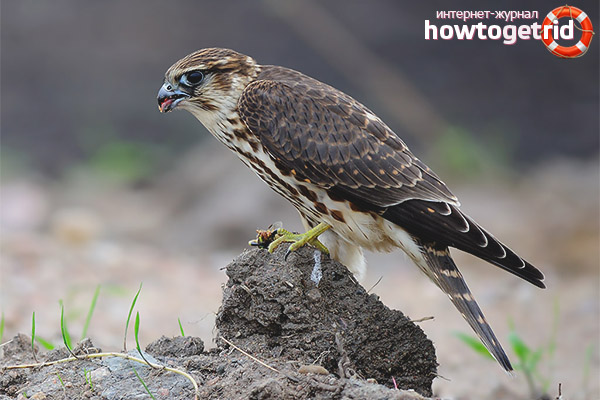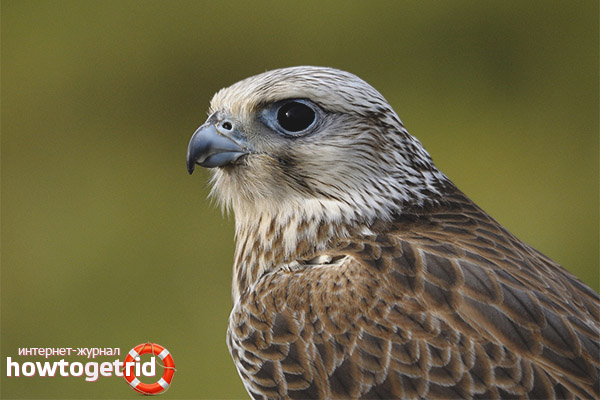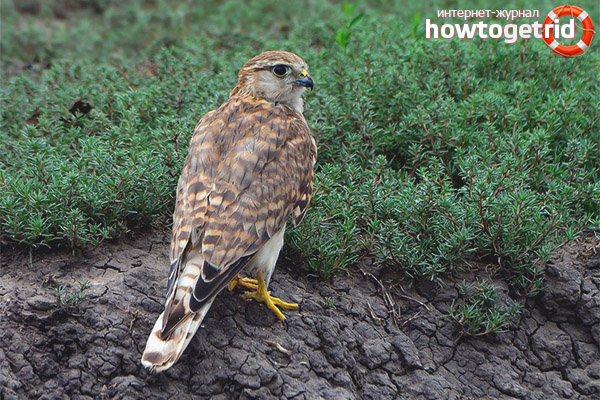The content of the article
Derbnik is a small bird of prey of the falcon family. Often, representatives of this species are also called by other, more well-known names for the average person: kobets, shotgun, and mousecatcher. This bird is quite rare, and it can be found in the Asian forest-steppe, in the eastern / northern part of Europe, in the north of America. The main food of the feathered predator is small birds, less often - lizards, rodents and some species of insects. The average lifespan of a falcon in the wild is several tens of years.
View description
Derbnik is a small stocky bird of a subspecies of the order of falcons, which has a sufficiently long tail and short wings. The average body size is up to 32 cm, the wingspan is up to 73 cm. As a rule, the female derbnik is larger than the male (by one third), the maximum bird weight reaches 315 grams. The color of the plumage between the individuals of the male and female has differences.
The male falconer of the arboretum has a gray back with a brown or purple tint and the upper part (head, shoulders) arranged longitudinally with black mottles. The belly of the bird is a reddish hue with a smooth transition from pale beige to rich red with brown touches. The falcon's neck seems lighter, due to almost imperceptible streaks. The “antennae” characteristic of most species of the falconry order is not very pronounced. The tail has a long and wide strip along the entire edge, the wings are bluish-brown.
Females of derbnik have a plumage color, which is more similar to a balaban - the back is dark brown and a gray stomach, mottled with small mottles. The bird's tail is decorated with alternating cream and dark brown stripes, the end is light.
The beak of the shotgun falcon is gray-brown, the legs and wax are yellow, the iris is dark. Young individuals of derbnik have plumage similar to the feather attire of an adult female.
I would like to note that the color of the bird directly depends on the habitat, because of which the representatives of the Mousecatcher are divided into several corresponding subspecies.
In the air, the bird is very similar to a swallow, which is manifested by a quick, maneuverable flight and soaring in the air. During the hunt, grasshopper flies very low above the surface of the earth.
Power Features
The main diet of the falcon falcon is small birds caught during hunting, which include sparrows, swallows, blackbirds, waders. In addition to birds, rodents, snakes, and some species of insects are also present in the diet of dernik, however, the falcon hunts them much less often. Cases have been recorded when a predatory feathered hunted for fairly large dragonflies.
Directly hunting, derbnik hovering in the air low above the ground, carefully looking for its prey. The peculiarity of this species of birds is that the mare can hunt in pairs not only during the nesting period, but also at other times. Often you can see a joint hunting of sweetlings with small hawks, while looking for prey for food, birds are in the air above each other at a distance of 10-20 meters.
Species distribution

The habitat of the fernbill falcon is quite wide, despite the fact that the population of the species is small. Most often, this species of predatory birds is found in Europe and in Asia. In America, the korean falcon is more common in the northern part of the continent.
For its habitat, the predatory bird prefers to choose landscapes characterized by open terrain. Most often, the kobets falcon is found in the tundra, and in the northern regions of the taiga (the largest distribution of the derbnik population).Bird nesting places are highlands (at least 2,000 meters above sea level).
Falcon derbnik refers to migratory species of birds. Nevertheless, some bird colonies lead a sedentary lifestyle, which is what climatic conditions have. For wintering colonies of feathered predators go to the north of Africa, Asia.
Today, there are many subspecies of derbnik, which can be divided into American and Eurasian.
Differences between female and male
A characteristic difference between the predatory bird species is pronounced sexual dimorphism. First of all, this is manifested by the larger size of the female mousecatcher falcon (by one third), respectively, the maximum mass of derbnik's girlfriend reaches 311-315 grams.
Another significant difference between the female and the male is the color of the plumage of this species of bird.
Reproduction of derbnik
Maturation of the derbnik falcon occurs when the bird reaches one year. Birds fly to the place of future nesting in the middle of spring. It should be noted that males of the harbinger falcon are the first to arrive at the site of future nesting and subsequent breeding. Females join later - after a few days.
The location of the nest of this small bird of prey directly depends on the landscape features of the surrounding area. So, for example, in the steppe region, a bird can make a nest directly on the ground, in this case, thickets of vegetation or shrubs can serve as a shelter. In a wooded area, these birds can use old crow nests, which are located on trees. Under tundra conditions, where vegetation is sparse enough, grasshopper chooses rocky ledges for erecting nests.
If the bird erects a nest directly on the surface of the earth, in this case a falcon breaks out a small depression in the ground (up to 30 mm). As a rule, the distance between the nests of representatives of this species is not less than 1.2-1.5 km. During the nesting and breeding season, derbniks begin to show aggression towards most species of birds and animals.
The average number of eggs in one clutch is from 3 to 5. Each egg is laid by the female with a break of 48 hours. Eggs are brownish in color, densely covered with dark spots. Hatching offspring is carried out by both birds, partners succeed each other for rest and hunting at certain intervals of time. The duration of the planting period is about one month (up to 32 days).
The appearance of offspring, hatching is carried out in the same order in which the eggs were laid. The chicks have a characteristic white downy outfit, which after several days is replaced by a more dense, gray color. Both the male and the female mousecatcher falcon take care of the brood that appears, which is manifested by feeding the chicks with their heating and periodic cleaning of the nest from food debris and bird droppings.
The first plumage of the chicks appears somewhere 2-3 weeks after hatching, as a rule, after that they begin to leave the parent's nest, although they have not yet become winged. The chicks get the ability to fly even after 2-3 weeks after the feathers completely replace the fluff.
The first food of young derbnik begin to be obtained at the age of 6-7 weeks, after which they are sent to the hibernation. The time of bird migration to warmer climes is August-September.
Voice Features
Falcon derbnik uncommunicative and silent species of predatory birds. As a rule, his voice can be heard only during the nesting period. Often a falcon makes sounds typical of this species when any disturbance arises (a sharp and jerky cry). The voice of female derbniks is higher.
Interesting facts about the species of predatory birds
Unlike other related species, falcon falcons always hunt for their prey in pairs. Note that from the outside, such hunting may seem like ordinary tomfoolery or a game of birds. Thus, derbnik imperceptibly for others is looking for its prey. Seeing an accessible victim, the couple immediately attacks her, leaving virtually no chance of escape and survival.
In the natural habitat, the falcon falcon can live up to 17 years. Nevertheless, there are cases when the life expectancy of representatives of this species was several tens of years (up to 25 years).
Currently, the falcon derbnik is under the protection of environmental organizations, this is due to a decrease in the population of the species.
Video: derbnik (Falco columbarius)











Submit